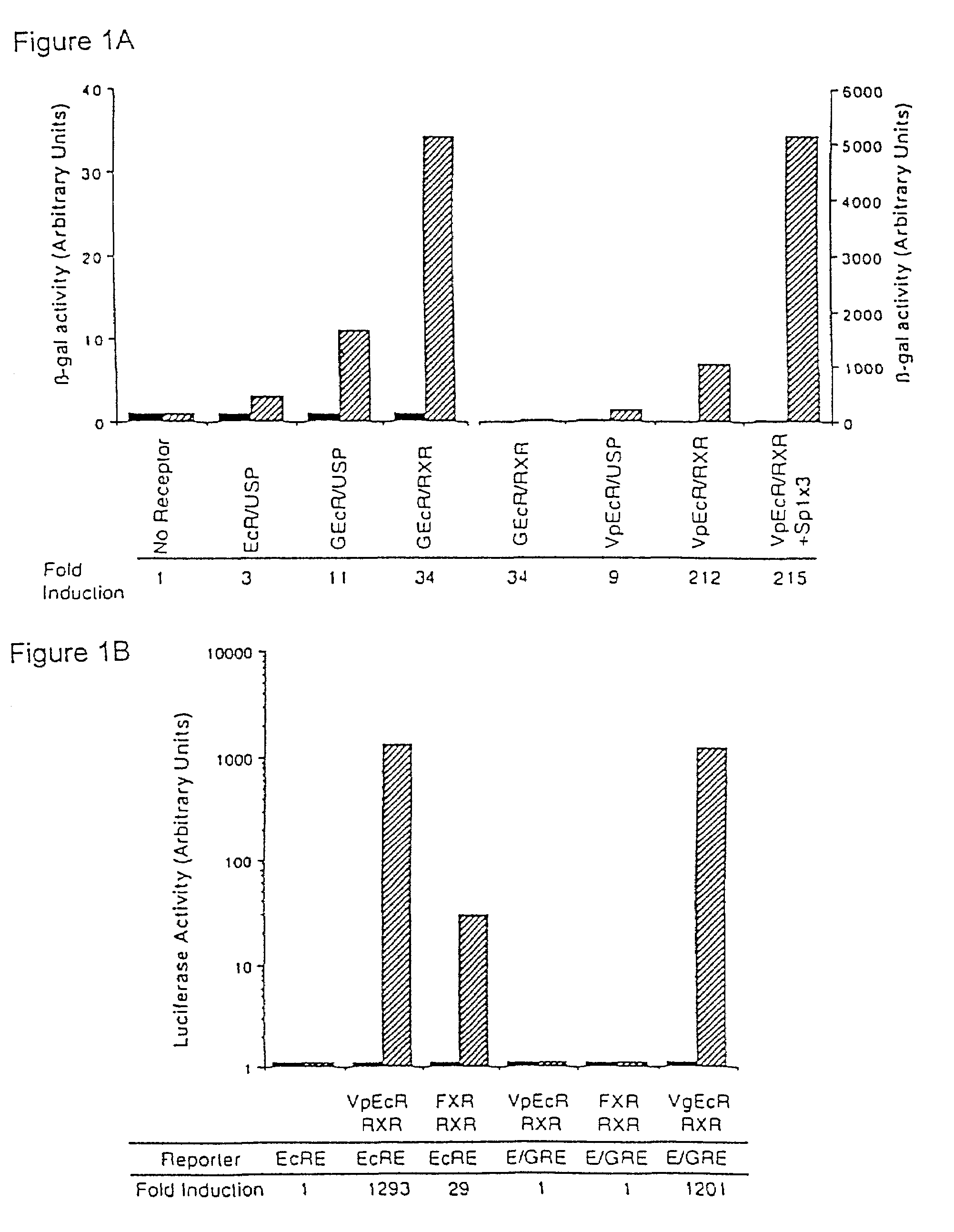Methods for modulating expression of exogenous genes in mammalian systems
a technology of exogenous genes and mammalian systems, applied in the field of recombinant dna technology, can solve the problems of slow clearance of antibiotics from bone, inability to regulate the specificity of mammalian genes, and interference with quick and precise induction, so as to prevent storage and facilitate clearance, short half-live
- Summary
- Abstract
- Description
- Claims
- Application Information
AI Technical Summary
Benefits of technology
Problems solved by technology
Method used
Image
Examples
example 1
Preparation of Modified Ecdysone Receptors
Plasmid Preparation:
[0194]The plasmids CMX-EcR, CMX-USP, CMX-FXR, CMX-hRXRa, EcREx5-ΔMTV-Luc, CMX-GEcR, MMTV-luc, and CMX-GR have been previously described (Yao et al., Nature 366:476–479 (1993) and Forman et al. Cell 81:687–693 (1995)).
[0195]The plasmid CMX-VpEcR was constructed by ligation of an EcoRI fragment of psk-EcR and CMX-Vp16.
[0196]The plasmid CMX-VgEcR was generated by site-directed mutagenesis of CMX-VpEcR using the Transformer Mutagenesis Kit (Clontech) and the mutagenic Oligonucleotide (SEQ ID NO:8):
[0197]
5′-TACAACGCCCTCACCTGTGGATCCTGCAAGGTGTTTCTTTCGACGCAGC-3′.
Mutagenesis of VpEcR to VgEcR altered the P-box region of the DNA binding domain of ecdysone receptor to resemble that of GR (Umesono and Evans, Cell 57:1139–1146 (1989)). The following amino acids in the DNA-binding domain of the ecdysone receptor were altered: E282G, G283S, and G286V (E=glutamate, G=glycine, S=serine, V=valine).
[0198]The reporter construct EcREx4-ΔHSP-β...
example 2
Construction of a Novel Ecdysone Response Element
[0208]Although no mammalian transcription factors have been shown to have a natural enhancer element like the ecdysone response element, which is composed of two inverted half-sites of the sequence AGGTCA spaced by one nucleotide, it is difficult to preclude such a possibility. The recently cloned farnesoid X receptor (FXR) can very weakly activate certain synthetic promoters containing an ecdysone response element in response to extremely high concentrations of farnesoids (Forman et al., Cell 81:687–693 (1995)).
[0209]In FXR containing cells and in transgenic mice, activation of gene expression by endogenous receptors would create undesirable background levels of reporter protein. To circumvent this potential problem, the DNA binding specificity of VpEcR was altered to mimic that of GR, which binds as a homodimer to an inverted repeat of the sequence AGAACA, spaced by three nucleotides. This altered binding specificity was achieved by...
example 3
Assay for Inducer Effectiveness on the Ecdysone-Inducible Expression System
[0210]CV-1 cells were maintained in DMEM supplemented with 10% fetal bovine serum. Transfections were performed using the Dotap transfection reagent (Boehringer Mannheim). All candidate inducers were dissolved in either ethanol or DMSO. Muristerone A (MurA) was used as a positive control for activation. All transfections were performed in triplicate.
[0211]Subconfluent CV-1 cells were transiently transfected with plasmids encoding the basic components of the invention ecdysone-inducible system (e.g., the VgEcR / RXR heterodimer) under the control of a strong constitutive promoter (e.g., CMX). The E / GRE4-ΔMTV-Luc plasmid is routinely used as a reporter. This plasmid (see No et al., Proc. Natl. Acad. Sci. U.S.A. 93:3346 (1996)) contains the firefly luciferase gene under the control of a minimal promoter and four binding sites for the VgEcR / RXR heterodimer. A CMX-β-gal reporter plasmid was included in the transfect...
PUM
| Property | Measurement | Unit |
|---|---|---|
| Therapeutic | aaaaa | aaaaa |
| Gene expression profile | aaaaa | aaaaa |
| Affinity | aaaaa | aaaaa |
Abstract
Description
Claims
Application Information
 Login to View More
Login to View More - R&D
- Intellectual Property
- Life Sciences
- Materials
- Tech Scout
- Unparalleled Data Quality
- Higher Quality Content
- 60% Fewer Hallucinations
Browse by: Latest US Patents, China's latest patents, Technical Efficacy Thesaurus, Application Domain, Technology Topic, Popular Technical Reports.
© 2025 PatSnap. All rights reserved.Legal|Privacy policy|Modern Slavery Act Transparency Statement|Sitemap|About US| Contact US: help@patsnap.com



